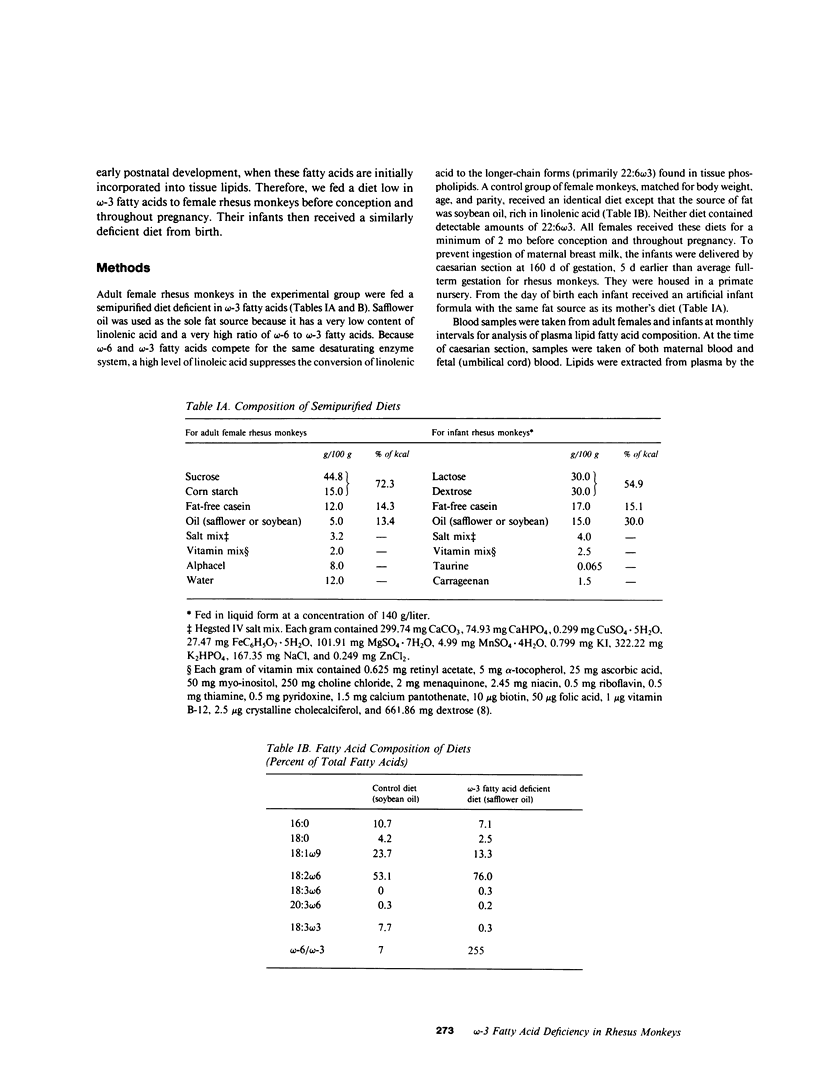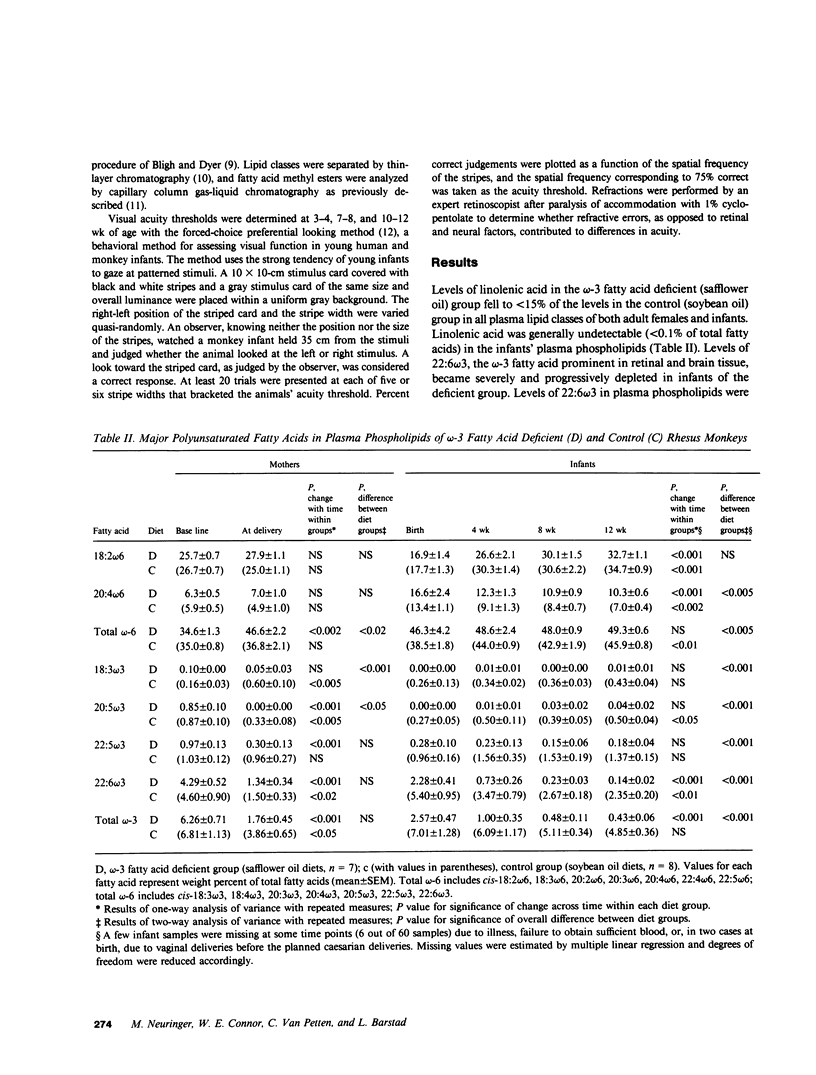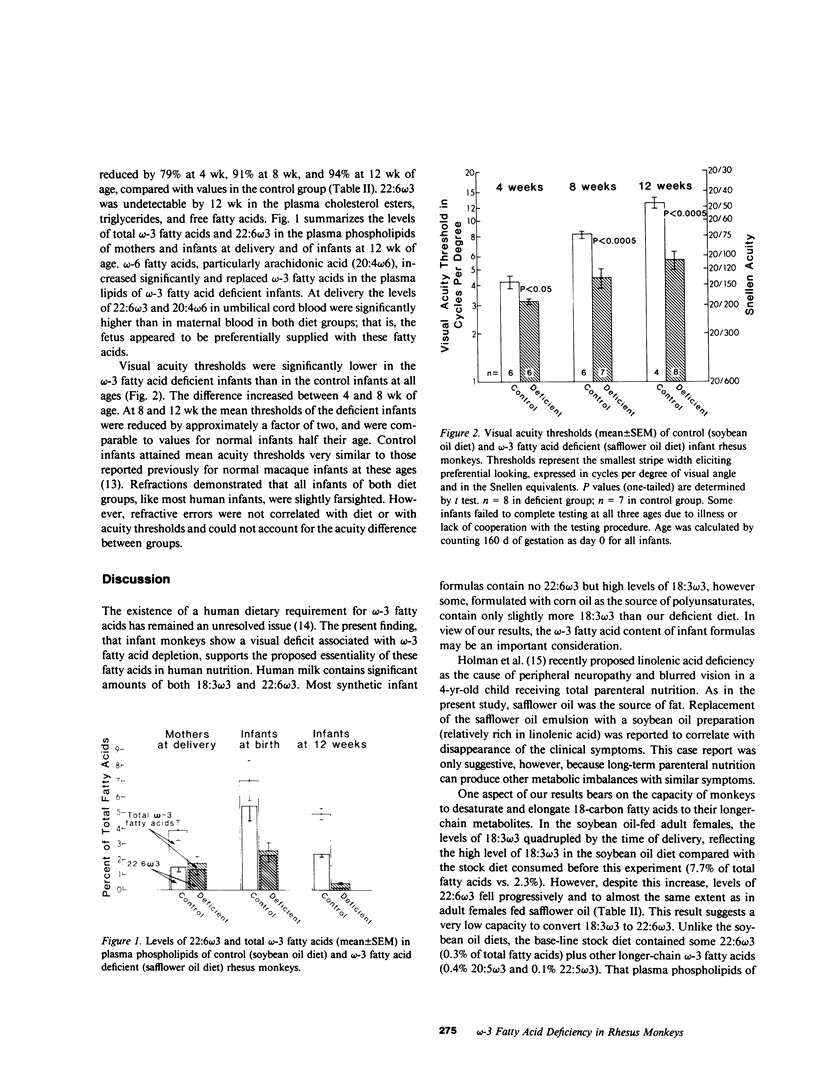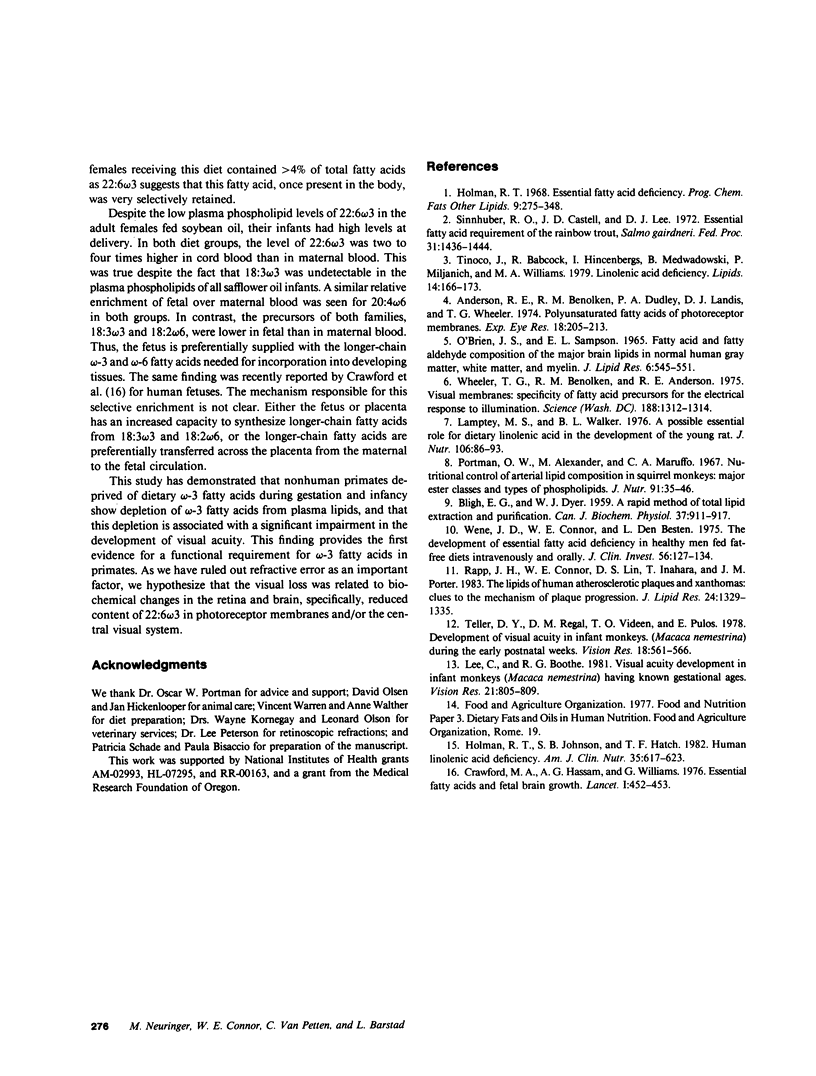Abstract
Linolenic acid (18:3 omega 3) is a dietary precursor of docosahexaenoic acid (22:6 omega 3), the major fatty acid in the photoreceptor membranes of the retina. We hypothesized that rhesus monkeys deprived of dietary omega-3 fatty acids during prenatal and postnatal development would show plasma depletion of these fatty acids and visual impairment. Semipurified diets low in omega-3 fatty acids were fed to one group of adult female rhesus monkeys throughout pregnancy and to their infants from birth. A control group of mothers and infants received similar diets but supplying ample linolenic acid. In the plasma phospholipids of deficient infants, linolenic acid was generally undetectable and 22:6 omega 3 levels became progressively depleted, falling from 42% of control values at birth to 21% at 4 wk, 9% at 8 wk, and 6% at 12 wk of age. In the other plasma lipid classes, 22:6 omega 3 was undetectable by 12 wk. The visual acuity of the deprived infants, as measured by the preferential looking method, was reduced by one-fourth at 4 wk (P less than 0.05) and by one-half at 8 and 12 wk (P less than 0.0005) compared with control infants. These results suggest that omega-3 fatty acids may be an essential nutrient, and that 22:6 omega 3 may have a specific function in the photoreceptor membranes of the retina.
Full text
PDF




Images in this article
Selected References
These references are in PubMed. This may not be the complete list of references from this article.
- Anderson R. E., Benolken R. M., Dudley P. A., Landis D. J., Wheeler T. G. Proceedings: Polyunsaturated fatty acids of photoreceptor membranes. Exp Eye Res. 1974 Mar;18(3):205–213. doi: 10.1016/0014-4835(74)90149-3. [DOI] [PubMed] [Google Scholar]
- BLIGH E. G., DYER W. J. A rapid method of total lipid extraction and purification. Can J Biochem Physiol. 1959 Aug;37(8):911–917. doi: 10.1139/o59-099. [DOI] [PubMed] [Google Scholar]
- Crawford M. A., Hassam A. G., Williams G. Essential fatty acids and fetal brain growth. Lancet. 1976 Feb 28;1(7957):452–453. doi: 10.1016/s0140-6736(76)91476-8. [DOI] [PubMed] [Google Scholar]
- Holman R. T., Johnson S. B., Hatch T. F. A case of human linolenic acid deficiency involving neurological abnormalities. Am J Clin Nutr. 1982 Mar;35(3):617–623. doi: 10.1093/ajcn/35.3.617. [DOI] [PubMed] [Google Scholar]
- Lamptey M. S., Walker B. L. A possible essential role for dietary linolenic acid in the development of the young rat. J Nutr. 1976 Jan;106(1):86–93. doi: 10.1093/jn/106.1.86. [DOI] [PubMed] [Google Scholar]
- Lee C. P., Boothe R. G. Visual acuity development in infant monkeys (Macaca nemestrina) having known gestational ages. Vision Res. 1981;21(6):805–809. doi: 10.1016/0042-6989(81)90178-4. [DOI] [PubMed] [Google Scholar]
- O'Brien J. S., Sampson E. L. Fatty acid and fatty aldehyde composition of the major brain lipids in normal human gray matter, white matter, and myelin. J Lipid Res. 1965 Oct;6(4):545–551. [PubMed] [Google Scholar]
- Portman O. W., Alexander M., Maruffo C. A. Nutritional control of arterial lipid composition in squirrel monkeys: major ester classes and types of phospholipids. J Nutr. 1967 Jan;91(1):35–46. doi: 10.1093/jn/91.1.35. [DOI] [PubMed] [Google Scholar]
- Rapp J. H., Connor W. E., Lin D. S., Inahara T., Porter J. M. Lipids of human atherosclerotic plaques and xanthomas: clues to the mechanism of plaque progression. J Lipid Res. 1983 Oct;24(10):1329–1335. [PubMed] [Google Scholar]
- Sinnhuber R. O., Castell J. D., Lee D. J. Essential fatty acid requirement of the rainbow trout, Salmo gairdneri. Fed Proc. 1972 Sep-Oct;31(5):1436–1441. [PubMed] [Google Scholar]
- Teller D. Y., Regal D. M., Videen T. O., Pulos E. Development of visual acuity in infant monkeys (Macaca nemestrina) during the early postnatal weeks. Vision Res. 1978;18(5):561–566. doi: 10.1016/0042-6989(78)90203-1. [DOI] [PubMed] [Google Scholar]
- Tinoco J., Babcock R., Hincenbergs I., Medwadowski B., Miljanich P., Williams M. A. Linolenic acid deficiency. Lipids. 1979 Feb;14(2):166–173. doi: 10.1007/BF02533868. [DOI] [PubMed] [Google Scholar]
- Wene J. D., Connor W. E., DenBesten L. The development of essential fatty acid deficiency in healthy men fed fat-free diets intravenously and orally. J Clin Invest. 1975 Jul;56(1):127–134. doi: 10.1172/JCI108061. [DOI] [PMC free article] [PubMed] [Google Scholar]
- Wheeler T. G., Benolken R. M., Anderson R. E. Visual membranes: specificity of fatty acid precursors for the electrical response to illumination. Science. 1975 Jun 27;188(4195):1312–1314. doi: 10.1126/science.1145197. [DOI] [PubMed] [Google Scholar]



